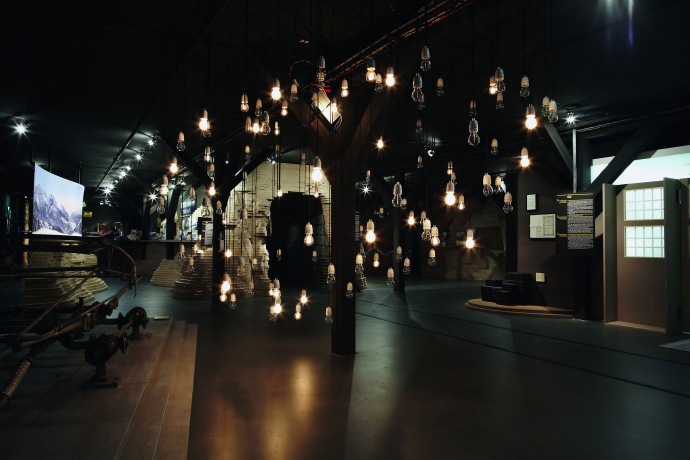Landwasser Viaduct Experience.
Spectacular and World Famous
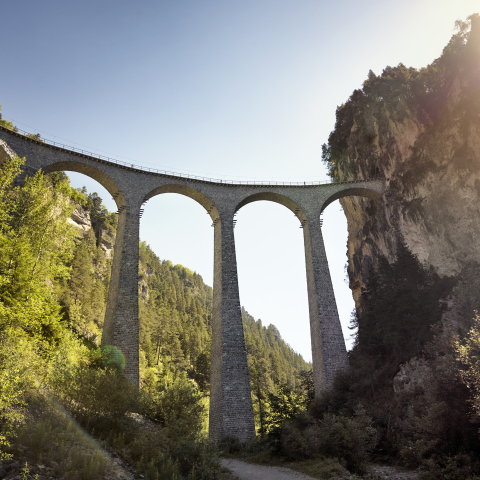
The Landwasser Viaduct is one of the most-photographed attractions in Graubünden. Over 3,300 posts can be found on Instagram, the world’s digital photo album. Passengers or hikers document «their viaduct» in the most beautiful situations, whether it be in heavy driving snow, in the spring, at sunset, from a worm’s-eye view or as a selfie with a dog (see tip «The best photo spots»).
The incomparably beautifully curved six-arched bridge with massive stone pillars that taper at the top is undoubtedly the most fascinating structure in the Rhaetian Railway network. The imposing bridge on the Albula line between Thusis and St. Moritz leads the train line in a radius of a hundred metres over the wild Landwasser valley directly towards a tunnel in the steep rock face. Those who have already travelled over the viaduct as a train passenger or have stood underneath the structure know its magical appeal. The moment when «the little red one», as the Rhaetian Railway compositions are known, travels over the 65-metre-high viaduct and disappears into the mountain: simply spectacular.
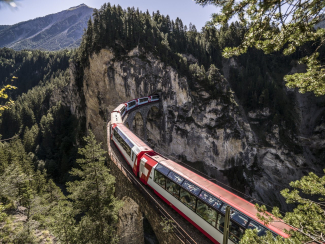
Architectural Masterpiece
Experts and laypeople alike are constantly astounded by the Landwasser Viaduct. The construction of the three main pillars of the viaduct in 1901 and 1902 was an architectural masterpiece. In contrast to most other bridges and viaducts of the time, a wooden falsework was not created. Instead, when building the Landwasser Viaduct, the three central pillars were lifted individually using a hoist. Crane-like iron connecting bridges between the pillars made it possible to lift up the stones, which were mined, carved and transported on rail transport wagons, from the valley below. Wooden falseworks, which had to hold the stones for the archways during the construction phase, were only required for the round arches. It is still possible today to see the iron girders on which the wooden framework rested at the upper end of the pillars.
In addition to tunnels (115) and galleries (43), the difficult topographical conditions in Graubünden also require a large number of viaducts within the Rhaetian Railway network. The network includes a total of 624 bridges. These railway bridges are cultural assets and stand as witnesses in the over 130-year history of the Rhaetian Railway to the outstanding achievements of the engineering pioneers of the time, who planned their engineering structures with a high degree of engineering and technical expertise.
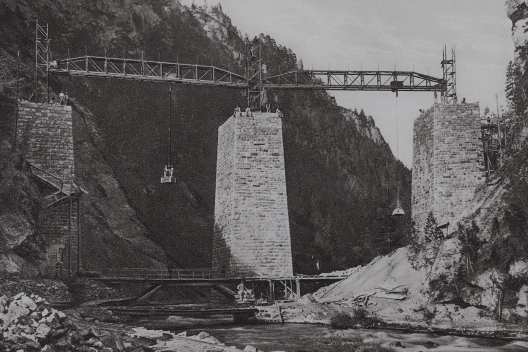
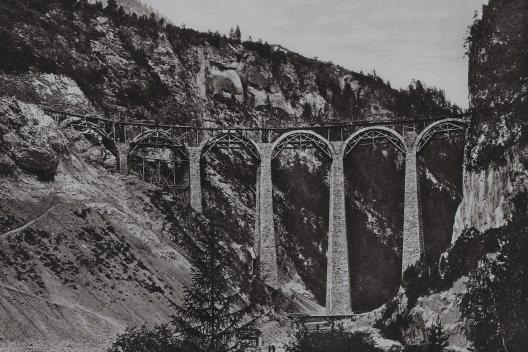
Engineering Structures as Tourist Attractions
The Landwasser Viaduct marked a turning point in the history of Graubünden bridge-building: with the construction of the Albula Railway, a new relationship between engineering and tourism emerged – the railway was no longer viewed purely as a mode of transport but also as a tourist attraction. What was new was not so much the attention paid by the travellers to engineering structures, but the large number and constant repetition of these attractions. The value of the engineering structures along the railway lines lay, and still lies, in the way the structures interact with each other. For instance, the Landwasser Viaduct and neighbouring Schmittnertobel Viaduct with the Zalain Tunnel in-between form a classic ensemble.
Around 22,000 trains a year cross the Landwasser Viaduct today. They provide many opportunities to experience the moment when the “little red one” sweeps over the 120-year-old viaduct, takes the tight curve and disappears into the tunnel in the rock face. Simply magic.
The Most Beautiful Photo Spots
Landwasser Viaduct Filisur Viewing Platform (South)
The viewing platform opens up an impressive view of the viaduct. Approx. a 20-minute walk from Filisur station/car park.
At the Foot of the Viaduct
The structure appears even more majestic from below. A small information kiosk, seating, a barbecue area and toilets can be found in the square directly at the foot of the viaduct during the summer months. Perfect for spending some time, having something to eat or drink, and waiting for the next train that rolls over the viaduct. Approx. 10 minutes from the Landwasser Viaduct car park. Approx. 35 minutes from Filisur station/car park.
Landwasser Viaduct Schmitten Viewing Platform (North)
This photo spot offers a unique view of the tracks from above, over the viaduct to the other side of the slope, where the first viewing platform can be found. The path that leads up from the viaduct square is relatively steep. Approx. 20 minutes from the Landwasser Viaduct car park. Approx. 45 minutes from Filisur station/car park.




